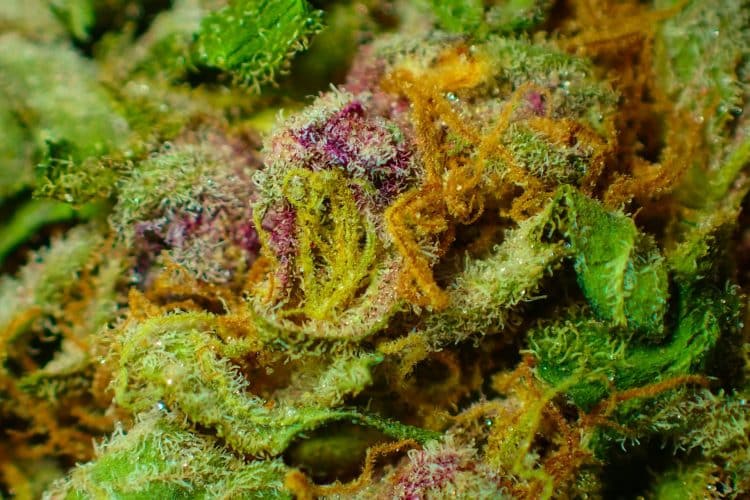Supercritical carbon dioxide (CO2) extraction is among the most popular extraction techniques for cannabis. Benefits include safety, recyclability, low solvent and running costs, and solvent-free extracts. A gas at ambient conditions, CO2 converts to a supercritical state at 73.8 bar and 31.1ºC. [1] This gives it solvent power with liquid-like density and gas-like viscosity. The temperature and pressure can be tweaked to dial the solvency toward or against certain compounds.
This selectivity is a key feature of supercritical CO2. Pressure and temperature can be changed to modulate solvating power, as can adding a co-solvent such as ethanol. As an example, one study [2] evaluated these parameters and maximized tetrahydrocannabinol (THC) extraction at 150 bar, 60ºC, and 2% ethanol (~38% THC).
At the other end of the spectrum, pressure and temperature can be dialed down to a subcritical state, which is appropriate for volatile, thermo-labile terpenes. An active patent breaks down the pressure-based selectivity of subcritical CO2 (maintaining low temperatures) as follows:
- Low-pressure extraction (34.5 to 48.5 bar): thin oil high in terpenes
- Medium-pressure (62.0 to 137.9 bar): high terpenes and cannabinoids without waxes
- Very high-pressure (172.4 to 344.7 bar): high terpenes and cannabinoids with thick waxes
This affords extractors a great deal of customization compared to conventional solvents. That said, Qamar et al [1] note that “the ‘fine tuning’ process can be difficult.” Changing a single temperature degree or pressure unit may alter solvent properties (e.g., diffusivity).
Extractors must also understand the solubility of different target compounds. The solubility of cannabinol (CBN), cannabigerol (CBG), cannabidiol (CBD), and THC differ in supercritical CO2; one study [3] reported the order of molar solubility as THC < CBG < CBD < CBN.
It follows that there are many examples of supercritical CO2 strategies for medicinal cannabis. A design of experiments approach that we covered last year highlighted a high flow rate (150 g/min), high pressure (300 bar), and lengthy time (10 hours) to generate the highest yields and recoveries of THC and CBD. Another group recently optimized the extraction of 11 cannabinoids at 37ºC and 250 bar with a customized extraction system.
Winterization with ethanol is a common post-extraction procedure to remove waxes and lipids from the supercritical CO2 crude extract. However, Thar Process developed a patent-pending process for in-line winterization without ethanol that modulates CO2 pressure across separating columns.
Supercritical CO2 extraction can be paired with analytical equipment such as gas chromatography/mass spectrometry to quantify cannabinoids and terpenes. Supercritical CO2 chromatography relies on supercritical CO2 as a mobile phase to purify extracts, isolate cannabinoids, and remediate batches (e.g., THC or pesticide remediation).
Perhaps the most commonly cited disadvantage to supercritical CO2 extraction is the initial cost of the equipment, including “high-grade stainless steel to maintain the high pressure.” [1]
Overall, supercritical CO2 is a green extraction method with extraordinary potential to customize, purify, and quantify medicinal cannabis extracts.
References
1- Qamar S, Torres YJM, Parekh HS, Robert Falconer J. Extraction of medicinal cannabinoids through supercritical carbon dioxide technologies: A review. J Chromatogr B Analyt Technol Biomed Life Sci. 2021;1167:122581. doi:10.1016/j.jchromb.2021.122581. [Impact Factor: 3.205; Times Cited: n/a]
2- Gallo-Molina AC, et al. Extraction, isolation and purification of tetrahydrocannabinol from the Cannabis sativa plant using supercritical fluid extraction and solid phase extraction. J Supercrit Fluids. 2019;146:208-216. doi:https://doi.org/10.1016/j.supflu.2019.01.020. [Impact Factor: 4.577; Times Cited: 28 (Semantic Scholar)]
3- Perrotin-Brunel H, et al. Solubility of non-psychoactive cannabinoids in supercritical carbon dioxide and comparison with psychoactive cannabinoids. J Supercrit Fluids. 2010;55(2):603-608. doi:https://doi.org/10.1016/j.supflu.2010.09.011. [Impact Factor: 4.577; Times Cited: 43 (Semantic Scholar)]
Image: David Cardinez from Pixabay











